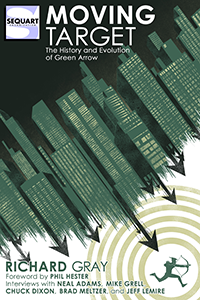In a nice little bit of comic book public relations, I heard Terry Gross’s interview with Steven T. Seagle this past Wednesday on National Public Radio. Seagle, writer of such Vertigo titles as Sandman Mystery Theatre and House of Secrets, was there to plug his new Vertigo graphic novel It’s a Bird…, a semi-autobiographical story about how the main character’s life as a comic book writer connects with the icon he reluctantly agrees to write: Superman. The interview was quite insightful (as are most of Terry Gross’s) and it made me want to pick up the book but, on top of that, I was very pleased to hear Seagle clearly state that the medium of sequential art was much more than just a playground for youngsters. He expressed to listeners that there is some heady stuff going on in this industry that adults would fully enjoy. Cheers to Terry for putting him on and to Seagle for doing more than just plugging himself..
More Comics in the National Spotlight
First Seagle, and now Meltzer. In another bit of comic news for the layman, novelist Brad Meltzer’s crossover into the sequential art genre has been drawing some major attention. Check out these quotes:
“In the world of comics this is the event of 2004.” — Liz Smith, New York Post
“The Identity Crisis mystery involves the biggest DC heroes and will use all of Mr. Meltzer’s skills as a thriller novelist.” — The New York Times
“In his comic book IDENTITY CRISIS, mystery novelist Brad Meltzer shows that even super-heroes have reasons to be afraid.” — Spin
Issue #1 of Meltzer’s six-part murder mystery has just hit the stands.
News Blips
- In lawsuit news, Carmine Infantino is trying to put the squeeze on DC for allegedly not compensating him properly after his 1956 revamp of the lagging Flash character. He claims that he owns the rights to the revamped version of the Flash as well as Batgirl and few others. His reasoning for going after DC is, in part, due to the large amounts of cash these properties could generate in today’s market, “Obviously the characters have much more commercial value these days. Look at the Spider-Man movies.”
- In the works for Jeff Smith is the phone book-sized Complete Bone. At a mere 1300+ pages, this doorstop will arrive in stores in July.
- In a follow-up to information posted in The Comics Blotter #8, there is some good news for those of you who can’t get enough imprints. DC has recently acquired the domain name cmxmanga.com for its new imprint that will release, you guessed it, manga related titles.
- Marvel’s new prose imprint “Marvel Press” will target its material toward three age groups. It will be broken down into a category for kids, one for young adults, and the third for adults. So far, the most notable releases include Mary Jane II, due this month and aimed at young females; and an adult Wolverine novel, coming out in October.
- Here is a batch of exclusive contracts for the Big Two: NYX‘s Josh Middleton and Promethea‘s Mick Gray have signed with DC for two years, Mark Millar has done the same with Marvel, and Chris Claremont has also signed for two years with (big surprise) Marvel.
- If you haven’t yet heard, be on the lookout for a 12-issue maxi-series called Justice League Elite. Written by Joe Kelly and drawn by Doug Mahnke, this series (which, if sales are good enough, could turn into an ongoing) will detail a much darker team that will be doing more proactive undercover work in order to nab criminals from inside their networks rather than just react to catastrophes like the normal JLA.
Trade Maneuver Opens a Can of Worms
Peter David, while remarking on his DC title Fallen Angel, made some telling statements about how the industry has changed the way it uses trade paperbacks. During the interview he was saying that DC would be gauging the title’s success by how well its first trade does on top of single-issue sales. “That’s one of the reasons I have issues #12, #13 and #14 each being stand-alones: So anyone who buys the trade and wants to check out what’s currently going on can do so without coming into the middle of a multi-part story.” The crux of the matter is that so many people these days wait for the trade and David’s statement indicates that this is affecting the way he’s had to put together Angel‘s story. According to the comment, in order to avoid cancellation he has prepared jumping-on points for a new, post-trade audience! Should trade sales shape how a plot unfolds? What will David do when it is time to compile the second trade? Will he prepare more newbie-friendly stand-alones to follow that? Maybe it’s just because Fallen Angel is new and after a while this strategy won’t be needed. Or, if it works well, maybe this will lead to a trend for even long-standing titles. It wouldn’t be the first time story took a backseat to sales.
But I digress. David is just trying to play the game and you can’t blame him for that. According to a new report released by ICv2, “the U.S. and Canadian market for graphic novels grew approximately 50% last year, to around $165 million at retail.” That has to be in the back of a writer’s mind when plotting the next six months to a year. With the trade paperback numbers soaring it would be bad for business to ignore a strategy for moving more copies. Yep, that’s what it’s all about.
Now talk back.





















































